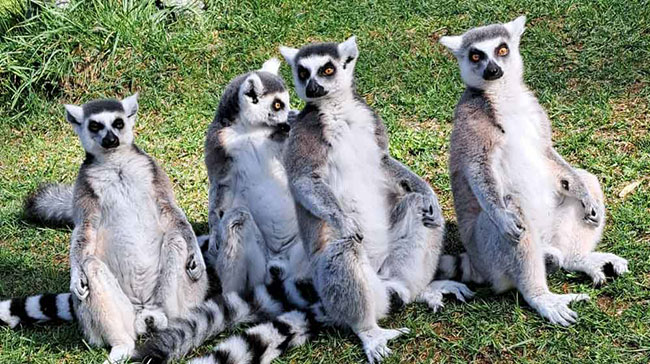Lemur: The Symbol of Madagascar
Lemurs are a group of primates native only to Madagascar. The word lemur comes from the Latin word lemures, meaning “ghost.” This name was given because, when light falls on their eyes at night, they look ghost-like.
Naturally, lemurs are found only in Madagascar. It is believed that they appeared on the island around 65 million years ago and since then have adapted to Madagascar’s unique climate.
Before humans arrived in Madagascar about 2,000 years ago, there were even giant lemurs as big as adult male gorillas. Today, Madagascar is home to nearly 100 species of lemurs.
Some people think lemurs evolved from monkeys or human ancestors, but this is not exactly true. They originated and evolved independently in Madagascar.
Origin and Evolution
Lemurs live mainly on Madagascar and a few nearby islands, such as the Comoros. Scientists believe that 40–50 million years ago, some primitive primates drifted across the sea from mainland Africa and reached Madagascar.
In the absence of predators and competition, they gradually evolved into various types of lemurs. Today, there are about 113 recognized species, differing in size, behavior, diet, and habitat. Some look like small cats, while others resemble medium-sized dogs.
Habitat and Lifestyle
Lemurs live in different forest types of Madagascar, including:
Rainforests (warm and humid)
Dry deciduous forests (seasonally dry)
Spiny forests (with thorny plants)
They are mostly arboreal (tree-dwelling), leaping between branches. Depending on the species, some are active during the day, while others are nocturnal.
Social Behavior
Lemurs often live in groups, and interestingly, in some species females are the leaders — a rare case in the animal kingdom. They communicate by scent-marking, licking, and vocal calls.
Their social structures and behaviors vary widely. Larger lemurs are usually diurnal, while smaller species tend to be nocturnal. Though they live in groups, individuals often forage alone and rejoin the troop afterward.
Diet
Most lemurs are frugivores (fruit-eaters), but their diet can include insects, leaves, and flowers. Smaller species tend to eat more insects for extra protein and energy, while larger species eat mostly leaves and vegetation.
Ring-tailed lemurs are even known to graze on grass, making them more omnivorous. Research shows that although the smallest lemurs are capable of eating insects, they still prefer fruit whenever available.
Communication
Lemurs communicate primarily through scent and vocal sounds rather than body language. Ring-tailed lemurs, for example, use scent glands and loud calls. They can also display facial expressions, and sometimes even yawn as a threat gesture.
Notable Lemur Species
Ring-tailed Lemur (Lemur catta)
Most iconic species
Long black-and-white striped tail
Spends more time on the ground
Indri (Indri indri)
Largest living lemur
Skilled tree climber
Famous for loud, song-like calls
Mouse Lemur
Smallest primate in the world
Weighs only 30–50 grams
Nocturnal
Aye-aye (Daubentonia madagascariensis)
Strange-looking lemur with a long, thin middle finger
Uses its finger to tap and extract insects from wood
Considered a bad omen in local beliefs, making it vulnerable
Ecological Importance
Lemurs play a vital role in Madagascar’s ecosystem by dispersing seeds after eating fruits, helping regenerate forests and maintain ecological balance.
Conservation Status
According to the IUCN Red List, about 95% of lemur species are threatened with extinction. The main threats are:
Deforestation for farming, housing, and fuel
Hunting for bushmeat and the pet trade
Superstitions — some species are killed due to cultural beliefs
Climate change altering habitats and reducing food sources
Conservation Efforts
Several local and international organizations are working to save lemurs:
The Malagasy government has designated many forests as protected areas.
Duke Lemur Center (USA) is the largest research facility for lemurs.
Ecotourism is promoting conservation by encouraging locals to protect forests while benefiting from tourism.
Cultural Symbol and Popularity
Lemurs gained global fame through the animated film Madagascar, with the character King Julien based on a ring-tailed lemur. They are also featured in documentaries by BBC and National Geographic.
For Madagascar, lemurs are not just animals but symbols of its biodiversity. Losing them would mean destroying an entire ecological balance. Protecting lemurs requires awareness, forest conservation, and engaging local communities.
Sources:
IUCN Red List
National Geographic
Duke Lemur Center
Madagascar Fauna and Flora Group

